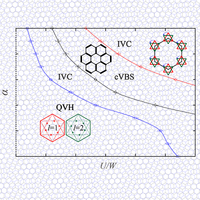Abstract
Twisted bilayer graphene (TBG) provides a unique framework to elucidate the interplay between strong correlations and topological phenomena in two-dimensional systems. The existence of multiple electronic degrees of freedom—charge, spin, and valley—gives rise to a plethora of possible ordered states and instabilities. Identifying which of them are realized in the regime of strong correlations is fundamental to shed light on the nature of the superconducting and correlated insulating states observed in the TBG experiments. Here, we use unbiased, sign-problem-free quantum Monte Carlo simulations to solve an effective interacting lattice model for TBG at charge neutrality. Besides the usual cluster Hubbard-like repulsion, this model also contains an assisted-hopping interaction that emerges due to the nontrivial topological properties of TBG. Such a nonlocal interaction fundamentally alters the phase diagram at charge neutrality, gapping the Dirac cones even for infinitesimally small interactions. As the interaction strength increases, a sequence of different correlated insulating phases emerge, including a quantum valley Hall state with topological edge states, an intervalley-coherent insulator, and a valence bond solid. The charge-neutrality correlated insulating phases discovered here provide the sought-after reference states needed for a comprehensive understanding of the insulating states at integer fillings and the proximate superconducting states of TBG.
1 More- Received 1 June 2020
- Accepted 24 November 2020
DOI:https://doi.org/10.1103/PhysRevX.11.011014
Published by the American Physical Society under the terms of the Creative Commons Attribution 4.0 International license. Further distribution of this work must maintain attribution to the author(s) and the published article’s title, journal citation, and DOI.
Published by the American Physical Society
Physics Subject Headings (PhySH)
Popular Summary
Twisted bilayer graphene (TBG) consists of two stacked layers of graphene rotated relative to one another. With a twist angle of about the so-called “magic” angle, many unconventional electronic behaviors emerge, including superconductivity and correlated insulators, a type of insulating phase that arises from interactions between electrons. Elucidating the mechanism responsible for these electronic states in magic-angle TBG is a problem at the frontier of quantum materials research. To help solve this problem, we employ an unbiased quantum many-body numerical method (quantum Monte Carlo simulations) to investigate the possible insulating phases of TBG.
Our large-scale simulations reveal a rich phase diagram, establishing the existence of three distinct insulating phases whose appearance can be controlled by tuning different types of interactions between the electrons. The first phase, called a quantum valley Hall state, has an insulating bulk and a dissipationless electronic current on its edge. The second phase, called an intervalley coherent state, is an insulator in which electron pairs emerge that behave in the same way as in a ferromagnet. The third phase, called a valence bond solid, is a phase realized in single-layer graphene if there were strong Coulomb interactions and electrons with degrees of freedom beyond just charge and spin (known as multiflavor electrons).
These results offer an unbiased solution for pristine TBG at charge neutrality, that is, the system has no extra electronic charge, and serves as the foundation for explanation of the more exotic behaviors of this fascinating material.



